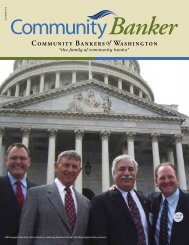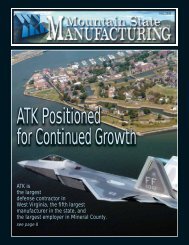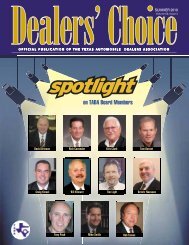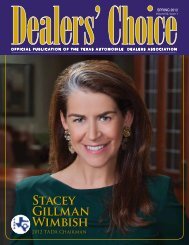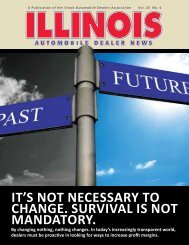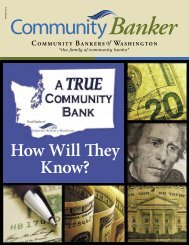Risk of Merchant Capture - Media Communication Group
Risk of Merchant Capture - Media Communication Group
Risk of Merchant Capture - Media Communication Group
- No tags were found...
You also want an ePaper? Increase the reach of your titles
YUMPU automatically turns print PDFs into web optimized ePapers that Google loves.
SPRING 2011OFFICIAL IPUBLICATION OF THE WEST VIRGINIA BANKERS ASSOCIATIONUnderstandingand Addressing<strong>Risk</strong> <strong>of</strong><strong>Merchant</strong><strong>Capture</strong>Inside:Nine Steps to the Purchase and <strong>Risk</strong>Management <strong>of</strong> BOLIBankers: Leading By Example
18224 Belated ResolutionsI wonder how many <strong>of</strong> us have already failed to keep oneor more <strong>of</strong> the resolutions we made two months ago. Theproblem with resolutions is most <strong>of</strong> us make them too hard tokeep.By Joe L. Ellison, President & CEO7 Nine Steps to the Purchase and <strong>Risk</strong>Management <strong>of</strong> BOLIBOLI can be used very effectively to cover the cost <strong>of</strong> a plandesigned to attract, retain, and reward the bank’s key talent.By Melissa K. Oliverio, JD and Michael A. Oliverio, II, MBA, The NorthwesternMutual Life Insurance Company11 Eighth Circuit Reaffirms the Importance <strong>of</strong>Accurately Listing a Debtor’s Name whenFiling UCC Financing StatementsIn a recent decision, the Bankruptcy Appellate Panel for theEighth Circuit Court <strong>of</strong> Appeals held that a UCC financingstatement failed to properly identify the debtor and that thecreditor had therefore failed to properly perfect its lien onthe collateral.By Julie Chincheck and Kristin Shaffer, Bowles Rice McDavid Graff & Love LLP16 Understanding and Addressing <strong>Risk</strong> <strong>of</strong><strong>Merchant</strong> <strong>Capture</strong>With the growing trend in the utilization <strong>of</strong> <strong>Merchant</strong> <strong>Capture</strong>,it is important to identify and address the risks introducedwith the service and the different method <strong>of</strong> delivery <strong>of</strong>customer deposit transactions.By Chris Joseph, CPA, CISA, Arnett & Foster, PLLC18 Consumer Protection: West Virginia DebtCollection ProvisionsWest Virginia-based financial institutions should endeavor tolearn about the intricacies <strong>of</strong> the WVCCPA and, if not alreadyin place, develop policies, procedures, and training programsto ensure they are not violating the WVCCPA when they arecollecting debts from consumers in West Virginia.By Angela L. Beblo, Esq. and Patrick R. Barry, Esq., Spilman Thomas & Battle, PLLC21 Bankers: Leading By ExampleYou can and do improve the quality <strong>of</strong> people’s lives – throughthe loans that you make and the savings that you keep safe – andall the other extras such as supporting charitable activities.By Gov. Frank Keating, President and CEO American Bankers Association22 Helping Residents Find Safe, AffordableHousingEven in these trying economic times, the West Virginia HousingDevelopment Fund is committed to providing affordable housingto the citizens <strong>of</strong> West Virginia.By Joe Hatfield, Executive Director, WV Housing Development Fund24 LSU Graduate School <strong>of</strong> BankingBy William A. Loving, Jr., President & CEO, Pendleton Community Bank25 Welcome Associate Members25 Member Notes26 Calendar <strong>of</strong> Eventsspring 2011 3
A MESSAGE FROM THE PRESIDENT AND CEOBy Joe L. EllisonBelated ResolutionsHow many <strong>of</strong> us have already failed to keep one or more <strong>of</strong>the resolutions we made two months ago.4As I write this for publication inMarch, the month <strong>of</strong> January isalmost over. I wonder how many<strong>of</strong> us have already failed to keep one ormore <strong>of</strong> the resolutions we made at thattime. The problem with resolutions ismost <strong>of</strong> us make them too hard to keep.With this in mind, may I suggest a fewbelated resolutions that each banker inWest Virginia should strive to keep.Resolution #1 –Increased involvement ingovernment relationsEveryone knows that our industry hasbeen under attack for nearly two and ahalf years now. Our readers also knowthat our members were not the culpritsin the financial/economic crisis.You can help your association and thebanking industry by staying up-to-dateon the WVBA’s government relationsefforts and more importantly, becominginvolved in them. You can also be<strong>of</strong> great service to the association andyour pr<strong>of</strong>ession by responding to calls <strong>of</strong>action when you receive our legislativeupdates and notices from our nationaltrade group.Resolution #2 – Continueto support the WVBABankPACWe made significant progress in ourpolitical action efforts in 2010. Weraised almost $70,000 last year alone asmore and more <strong>of</strong> our CEOs are heedingthe call to give by soliciting their boardsand management to support WVBABankPAC. There will be a special electionthis spring and fall for governorand then we’ll enter the 2012 electioncycle. 2010 will be vitally important tothe banking industry. West Virginiawill elect a governor, a U.S. Senator,three Congressional representatives andtwo justices to the State Supreme Courtin 2012, along with the entire House <strong>of</strong>Delegates, one-half <strong>of</strong> the State Senateand all other statewide elected <strong>of</strong>ficialsranging from the Attorney General tothe Auditor and Treasurer. We simplymust have as many bankers as possibleinvolved in our political efforts.Resolution #3 – Leverageour political relationshipsWe have two new members <strong>of</strong> Congress– Representative David McKinley andSenator Joe Manchin. We also have severalnew members <strong>of</strong> the West VirginiaHouse <strong>of</strong> Delegates and State Senate. Iam confident that many <strong>of</strong> our bankersknow these individuals and havestrong relationships with them. Likebanking, lawmaking is <strong>of</strong>ten centeredaround personal relationships and thetrust developed between community andeconomic leaders and elected <strong>of</strong>ficials.Recently, I took Randy Snider, Presidentand Chief Executive Officer <strong>of</strong>Community Bank <strong>of</strong> Parkersburg,and Charles Maddy, President andCEO <strong>of</strong> Summit Financial <strong>Group</strong>, tomeet our two new representatives inWashington, DC. They want to hearfrom you. Send them a personal note.Better yet, make it a point to go andsee them when they have a function inyour area.Let’s work hard to make sure our newmembers know and understand the importantrole banking plays in our stateand our nation’s economy.I am asking you to consider these resolutions.I am well aware <strong>of</strong> the manychallenges you already face and thatyour primary focus is to take care <strong>of</strong>your customers, your community, yourshareholders, and your employees. Butbeing actively involved in governmentrelations is important as well. Thelaws Congress and the state Legislaturepass have a huge impact on everyphase <strong>of</strong> your bank’s operations and,ultimately, its pr<strong>of</strong>itability.As for us, the WVBA staff is alwaysready to serve you and our resolutionfor this year and every year is to provideour full and ongoing support foryour bank and the great industry weare privileged to be a part <strong>of</strong>. www.wvbankers.org
Excellence. Value. Get There!SpilmanExcellence& ValueA Proven Combination for West Virginia BanksWhether working with large national financial institutions or small-town community banks, Spilman isuniquely qualified to assist in all aspects <strong>of</strong> the financial sector. From traditional banking and financematters to expanded needs involving government relations, regulatory compliance or employment law,Spilman’s focus is always on excellence and value. It’s how we help our clients Get There TM .W E S T V I R G I N I A N O R T H C A R O L I N A P E N N S Y L V A N I A V I R G I N I ABanking & Finance Team <strong>of</strong> 20+Community Banking Team <strong>of</strong> 25+Seven strategic <strong>of</strong>fice locationsTailored fee arrangementsA T T O R N E Y S A T L A W1.800.967.8251 | Responsible Attorney, Michael J. Basile | www.spilmanlaw.com
Nine Steps — continued from page 7take the mystery out <strong>of</strong> the purchase and risk management <strong>of</strong>BOLI products. In response to those questions we have developedthis “Nine Step Due Diligence Process.”Due to space limitations, this article will necessarily concentrateonly on whole life and general account universal lifeBOLI products, which constitute most <strong>of</strong> the BOLI productsfound in the market today.The “Nine Step” due diligence process is designed to helpminimize the risk that a bank will make some missteps inbuilding and/or managing its BOLI portfolio:1. The bank should review the insurance carrier’s ratingsfrom Best, S&P, Fitch, and Moody’s. The Guidelines statethat “carrier selection is one <strong>of</strong> the most critical decisionsin a BOLI purchase [and] credit quality is a key variable.”The ratings reflect the carrier’s claims paying ability, whichis the bank’s ultimate investment risk. The bank shouldalso review the carrier’s past financial ratings for trends. Itis important to note that out <strong>of</strong> about 1,000 life insurancecompanies in the US, only 40 have ever <strong>of</strong>fered an actualsingle premium BOLI product. Furthermore, to date, onlyabout half <strong>of</strong> these carriers are still active in the BOLImarket. As a result, it is important to properly evaluate aninsurance companies ratings.2. Is the carrier a stock or a mutual company? According toMoody’s 2005 Report on Life Insurers, “mutual companiesare relatively more concerned with solvency and financialstrength compared to the growth and pr<strong>of</strong>itability objectivesthat are typically the focus <strong>of</strong> stockholder-owned insurers.”Moody’s 2009 Report said that “the U.S. mutual lifeinsurance companies have more successfully protected andmaintained their credit worthiness than their stockholderownedrivals.” All things being equal, a mutual companymay be preferred.3. How efficiently does the carrier operate its business? Thebank should review the carrier’s operating fundamentals; i.e.,mortality and expenses, lapse ratios, and investment returns.A comparison should be made to other BOLI carriers. Thecomparison will show how efficiently the carrier operates,which may indicate how one BOLI product might performlong-term against another.4. Examine the BOLI illustration for cash values and deathbenefits at guaranteed charges and crediting rates. Most8www.wvbankers.org
Nine Steps — continued from page 9either withdrawn from the market or have suspended BOLIsales. The question is whether the carrier will continueto support its BOLI product if it is no longer active in themarket. Most BOLI products today have restrictions andpenalties that make it difficult to exchange out <strong>of</strong> a BOLIproduct. Getting it right from the start is very important.The opportunities to change carriers in the future can beseverely limited.8. Does the BOLI have breakpoints? Most BOLI productshave commission breakpoints. Typically, these breakpointsoccur at premium purchases <strong>of</strong> $5 and $10 million. Thelower commissions paid at these breakpoints can result in adirect improvement in the net crediting rate on the BOLI. Ifthe bank is close to obtaining a breakpoint, it should look tostructure its purchase to obtain that breakpoint. Diversificationis important but be mindful <strong>of</strong> breakpoints too.9. What are the bank’s options if the carrier has problems?One common misconception bankers may have about BOLIis that if the carrier has a problem the bank can alwaysexchange out <strong>of</strong> the product tax-free under Section 1035 <strong>of</strong>the Internal Revenue Code. This may not always be the case.First, the bank must have an insurable interest in the personinsured by the policy. If the insured person is no longeremployed at the bank, then the bank no longer has an insurableinterest and an exchange may not be made. Secondly,if the policy is medically underwritten and the insured hasexperienced health problems, an exchange may no longer bepossible. Finally, there could be exchange charges and restrictions,which would make it expensive or time consuming tomake the exchange.A second option is simply to surrender the policy. A surrender,however, would trigger income tax on the investmentgain in the policy plus a 10% tax (MEC) penalty on that gain.The bottom line is the bank should be aware <strong>of</strong> its limitedability to exchange out <strong>of</strong> a carrier’s BOLI product. Getting itright from the start is, therefore, extremely important.In conclusion, BOLI can be an excellent way for a bank to addressrising benefit costs. It can also be used very effectivelyto cover the cost <strong>of</strong> a plan designed to attract, retain, andreward the bank’s key talent. That being the case, the bank’sBOLI should be as strong as possible and hopefully this NineStep Die Diligence Process should help reach that goal. Melissa K. Oliverio and Michael A. Oliverio, II are Financial Representatives withThe Northwestern Mutual Life Insurance Company and are members <strong>of</strong> the MMBConsulting LLC, Service Team.REACHYOUR TARGETAUDIENCEAFFORDABLYFind out how targeted advertisingcan produce real, measurableresults for your organization.ADVERTISE ANDGET RESULTSKris Montione, Advertising Sales801.746.4003 | kris@spectruminkpublishing.com10www.wvbankers.org
In light <strong>of</strong> this decision, we recommend that creditors review the filingrules in every state where they operate and make sure that they correctlyidentify the debtor on every financing statement they file.a safe harbor if a lien search under the debtor’s “correct”name reveals the filing under an erroneous name. Theundisputed evidence showed that a search <strong>of</strong> the NebraskaSecretary <strong>of</strong> State’s records using the debtors’ correct name,“EDM Corporation” did not reveal Hastings’ filing. Therefore,Hastings’ addition <strong>of</strong> “d/b/a EDM Equipment” to thedebtor’s name field on the financing statement made thedocument seriously misleading, and Hastings’ failed to perfectits lien on the ambulance.The Eighth Circuit’s decision in EMD Corporation illustratesthat a creditor may fail to properly perfect its security interestif it includes too much information on a financing statement.The statutes considered by the Eighth Circuit in this decisionare similar to the UCC provisions adopted by the State <strong>of</strong>West Virginia and the majority <strong>of</strong> other states. In light <strong>of</strong> thisdecision, we recommend that creditors review the filing rulesin every state where they operate and make sure that theycorrectly identify the debtor on every financing statementthey file. We also recommend that creditors run a post-closinglien search to ensure that their UCC filings are properlyindexed and are disclosed in the lien search results. Should you require more information concerning the legal and businessaspects <strong>of</strong> the above, please feel free to contact the authors,Julie Chincheck, directly at (304) 347-1713 or via e-mail at jchincheck@bowlesrice.com, or Kristin Shaffer, directly at (304) 347-2127 or via e-mailat kshaffer@bowlesrice.com.Ms. Chincheck is a partner in Bowles Rice McDavid Graff & LoveLLP specializing in bankruptcy and commercial law. Kristin Shafferis an associate in Bowles Rice McDavid Graff & Love LLP specializingin bankruptcy, bank regulatory and commercial law. Bowles RiceMcDavid Graff & Love LLP is general counsel to the West VirginiaBankers Association.12www.wvbankers.org
Should you require more information, please feel free to contact theauthors, Sandra M. Murphy at (304) 347-1131 or via e-mail at smurphy@bowlesrice.com, or Amy J. Tawney at (304) 347-1123 or via e-mail atatawney@bowlesrice.com.Ms. Murphy and Ms. Tawney are partners in Bowles Rice McDavidGraff & Love LLP specializing in banking and commercial law. BowlesRice McDavid Graff & Love LLP is general counsel to the West VirginiaBankers Association.
eytdsia
The effect <strong>of</strong> the transaction is similar towhat deposit transactions have been inthe past. However, the delivery systemis different in that the transactions aredelivered electronically from remotelocations, even from customers. Therefore,remote deposit capture should beviewed not as just a new service, but as anew delivery system <strong>of</strong> “deposit taking.”Understanding andAddressing<strong>Risk</strong> <strong>of</strong> <strong>Merchant</strong><strong>Capture</strong>By Chris Joseph, CPA, CISAOpportunities and <strong>Risk</strong>s. The introduction<strong>of</strong> “remote” in the deposit captureprocess brings new opportunities t<strong>of</strong>inancial institutions. However, it alsointroduces new areas <strong>of</strong> risk that need tobe considered. The “traditional” deposittaking systems that have been in placefor years occurred predominantly at thebank. The transactions occurred at theteller line and then were processed at thebank’s back <strong>of</strong>fice area. The main emphasisin this environment was that theprocess was typically under the control<strong>of</strong> the bank. More specifically, withinthe control <strong>of</strong> specific bank employeesand departments that were trained in thearea and segregated from other operations<strong>of</strong> the bank. With remote depositcapture, deposit transactions are occurringat other locations such as otherlocations <strong>of</strong> the bank (i.e. branches,tellers) as well as at customers wherethe bank has little control over how theyfunction. With the introduction <strong>of</strong> customersperforming deposit transactionfunctions, an element <strong>of</strong> direct controlwas removed from the bank.While working on various bankclients and attendance at variousseminars, we have noted thatmore and more financial institutionsare <strong>of</strong>fering Remote <strong>Capture</strong> Servicesat their business/commercial customerlocations (<strong>Merchant</strong> <strong>Capture</strong>) as aservice to their customers. <strong>Merchant</strong><strong>Capture</strong> can provide several benefits toyour bank including increased efficienciesin processing deposits, decreasedcosts and if planned properly, increasedsecurity in some areas (especially asadvances in technology continue toimprove in areas such as signatureverification, etc.). However, there arealso additional risks that are introducedand they need to be consideredas the bank implements and monitorsthe ongoing operations <strong>of</strong> its <strong>Merchant</strong><strong>Capture</strong> solution.Electronic Delivery. Before gettinginto these risks, let’s take a moment todefine remote capture services. Remotecapture provides a bank the ability toreceive digital information from depositdocuments captured at remote locations.These locations could be from varioussources including:• Branch locations <strong>of</strong> the bank• ATMs• Correspondents – domestic and foreign• Customers – commercial and retailRegulatory Guidance. In January 2009,regulatory guidance was released regardingthe use <strong>of</strong> remote deposit capture.The guidance addressed the necessaryelements <strong>of</strong> remote deposit capture riskmanagement process which included:• <strong>Risk</strong> identification• Assessment• Mitigation• Measurement and monitoring <strong>of</strong>residual risk exposureRemoved from the thought process wasthat, if the customer was utilizing the<strong>Merchant</strong> <strong>Capture</strong> service, a bank did <strong>Merchant</strong> <strong>Capture</strong> — continued on page 1716www.wvbankers.org
<strong>Merchant</strong> <strong>Capture</strong> — continued from page 16not have to worry about the controls since it was not at their locationand under their direct control. The bank must include inits risk assessment process how the <strong>Merchant</strong> <strong>Capture</strong> solutionwas implemented. Depending on how the <strong>Merchant</strong> <strong>Capture</strong> solutionwas implemented, the bank’s risk assessment may have toinclude not only their own information technology systems, butalso those <strong>of</strong> other third-party service providers and customers.A couple <strong>of</strong> areas that should be considered include Confidentiality<strong>of</strong> Nonpublic Personal Information and Operational <strong>Risk</strong>s.Confidentiality <strong>of</strong> Nonpublic Personal Information. Whenimplementing the remote deposit capture solution, the requirementsunder the Interagency Guidelines EstablishingInformation Security Standards must be considered. In thetraditional deposit taking environment, the focus was on thecontrols at the bank and their employees. When <strong>Merchant</strong><strong>Capture</strong> is considered, the bank may have to include the controlsat their customers including:• Network security settings• Security <strong>of</strong> the solution utilized by the customer• Encryption• Reentry and repair• Physical security controls• Controls over and methods <strong>of</strong> destruction <strong>of</strong> originaltransactions• Customer employee training• Regulatory changesOperational <strong>Risk</strong>s. The operational risks that are introducedwith the implementation <strong>of</strong> <strong>Merchant</strong> <strong>Capture</strong> should also beunderstood. Some <strong>of</strong> these risks include:• Errors – Increased risk <strong>of</strong> errors due to being new to theprocess, absence <strong>of</strong> detective controls, diligence or lackthere<strong>of</strong> <strong>of</strong> customer employees (do they understand theimportance <strong>of</strong> the transaction)• Security – IT equipment and infrastructure (includingfirewalls, intrusion detection systems, intrusion preventionsystems), retention <strong>of</strong> original documents including policies,destruction policies including how are documents destroyedand frequency, confidentiality <strong>of</strong> nonpublic personalinformation as noted previously, logical access controls,employee turnover and employee separation controls andprocedures, disgruntled employees• Technological – Faulty equipment, compatibility issuesincluding upgrades to the remote deposit capture solution,patch management policies and procedures, anti-viruspolicies and procedures• Natural – Interruption <strong>of</strong> services including transactionprocessing (timely postings, duplication <strong>of</strong> postings, missingpostings), contingency planning• Fraud – Check alteration, segregation <strong>of</strong> duties, duplicatepresentment, identity theft<strong>Risk</strong> Assessment. How do you address these and other potentialrisks? The level <strong>of</strong> the risk assessment and controls toaddress the identified risks will be dependent on the solutionin place and the scope <strong>of</strong> the implementation. The risk assessmentshould involve the potential stakeholders <strong>of</strong> the solutionwhich could include personnel from multiple areas and thirdparties, depending on the complexity <strong>of</strong> the solution. Assumingthe risk assessment supports the conclusion that the risksassociated with remote deposit capture can be mitigated,measured and monitored the appropriate risk managementpolicies should be implemented. As in any risk assessmentprocess, the mitigating controls, tolerance levels, stakeholders,direction <strong>of</strong> risk and source <strong>of</strong> risk should be considered.Areas that may need to be considered by the bank to addressthe risk include:• Customer due diligence and suitability – customers shouldbe qualified based upon specific pre-defined guidelines thatconform to the bank’s risk tolerance for the service.• Vendor due diligence and suitability – proper controls in theselection and ongoing monitoring <strong>of</strong> solutions from thirdparties should be followed to assess the solutions in place bythe bank.• Training – Customer training should be conducted on aperiodic basis. Without proper training, customers may notunderstand the importance <strong>of</strong> their role in managing therisks, processing errors, unauthorized activity and privacy<strong>of</strong> nonpublic personal information. Periodic training isrecommended to address changes in regulations, bestpractices and employee turnover.• Contracts and agreements – The bank should considerdeveloping and using a strong contractual agreementwith their customers that includes provisions between thebank and their customer. The contract should address theroles and responsibilities <strong>of</strong> each party, record retention,termination clause, laws and regulations, etc. The bank’slegal counsel should be consulted when developing andmonitoring customer contract agreements.Conclusion. <strong>Merchant</strong> <strong>Capture</strong> provides banks with opportunitiesto provide additional services to their customerswith the possibilities <strong>of</strong> increasing efficiencies and reducingprocessing costs. With the growing trend in the utilization <strong>of</strong><strong>Merchant</strong> <strong>Capture</strong>, it is important to identify and address therisks introduced with the service and the different method <strong>of</strong>delivery <strong>of</strong> customer deposit transactions. An effective riskassessment for the service can be used to identify the significantrisks and provide the bank with the tool to develop theappropriate controls to mitigate and monitor the risk <strong>of</strong> usingthe <strong>Merchant</strong> <strong>Capture</strong> service. Chris Joseph is a P.L.L.C. Member <strong>of</strong> Arnett & Foster, P.L.L.C., Certified Public Accountants,in Charleston, West Virginia. A Certified Public Accountant and Certified InformationSystem Auditor, Mr. Joseph has over twenty-five years experience in informationtechnology audit and security services in the financial institutions industry. Mr. Josephcan be contacted at 800-642-3601 or through email: chris.joseph@afnetwork.com.spring 2011 17
Consumer Protection:West VirginiaDebt CollectionProvisionsBy Angela L. Beblo, Esq. and Patrick R. Barry, Esq., Spilman Thomas & Battle, PLLCOverview Of The DebtCollection ProvisionContained Within TheWVCCPAThe WVCCPA was passed into law in1974 and is incredibly consumer-friendly.The WVCCPA applies to consumerloans, credit sales, and leases. 1 Itproscribes the maximum charges andfees that may be imposed on accounts. 2The collection provisions 3 apply to alldebt collection activity – whether doneby third-party collectors or creditors/issuers seeking to collect against theircustomer. 4 In connection with collectingon a debt, the WVCCPA prohibits:(1) threats and coercion 5 ; (2) oppressionand abuse 6 ; (3) unreasonable publication7 ; (4) fraudulent, deceptive, ormisleading representations 8 ; (5) unfairor unconscionable conduct 9 ; (6) postalviolations 10 ; and (7) deceptive or oppressivetelephone calls. 11 Each <strong>of</strong> thesesections contains a non-exhaustive list<strong>of</strong> activities that are prohibited underthe WVCCPA.Next quarter’s article will focus on ananalysis <strong>of</strong> the types <strong>of</strong> claims typicallyasserted under the WVCCPA. In the past several years, there hasbeen an increase in cases assertingclaims under the West Virginia ConsumerCredit and Protection Act, W. Va.Code § 46A-1-101, et seq. (“WVCCPA”)relating to illegal debt collection. Thesuccess <strong>of</strong> early suits has lead to an increasednumber <strong>of</strong> these lawsuits. Thus,West Virginia-based financial institutionsshould endeavor to learn about theintricacies <strong>of</strong> the WVCCPA and, if notalready in place, develop policies, procedures,and training programs to ensurethey are not violating the WVCCPAwhen they are collecting debts fromconsumers in West Virginia.1W. Va. Code § 46A-1-104 (“This chapter applies if aconsumer, who is a resident <strong>of</strong> this state, is induced to enterinto a consumer credit sale made pursuant to a revolvingcharge account, to enter into a revolving charge account, toenter into a consumer loan made pursuant to a revolvingloan account, or to enter into a consumer lease [ ], and thegoods, services or proceeds are delivered to the consumer inthis state, and payment on such account is to be made fromthis state.”); W. Va. Code § 46A-1-102 (including definitions<strong>of</strong> the types <strong>of</strong> transactions subject to the Act).2Id. at 1-103, 2-115, 3-101 -109, 3-112 -117.3Over the next several quarters, weId. at 2-122 -129a.4will be providing information onId. at 2-122(c-d) (“debt collection” is defined as “any action,conduct or practice <strong>of</strong> soliciting claims for collection orthe WVCCPA and how it relates to in the collection <strong>of</strong> claims . . . alleged to be owed or due bya consumer” and “debt collector” is defined as “any personcollection efforts by financial institutions.We will begin with an overviewor organization engaging directly or indirectly in debt collection”;See Thomas v. Firestone Tire & Rubber Co., 164 W.Va. 763, 266 S.E.2d 905 (1980).<strong>of</strong> the WVCCPA, review each <strong>of</strong> the5W. Va. Code § 46A-2-124 (including, but not limited too,individual sections, and finish with (a) the use or threat <strong>of</strong> violence, (b) threat or accusation <strong>of</strong>threat that a person has committed a fraud or crime andrecommendations and considerations that would tend to disgrace the person accused, (c) falseaccusations <strong>of</strong> failure to pay, including information reportedfor the future. The WVCCPA canto a credit agency, and (d) threatening arrest or garnishmentwithout first explaining that judicial order must be in effect).significantly impact the way any financialinstitution does business, making language, (b) a caller’s failure to identify themselves and with6Id. at 2-125 (including (a) using obscene or pr<strong>of</strong>anethe intent to annoy, harass or threaten the person called, (c)an understanding <strong>of</strong> the WVCCPA’scausing a person to incur charges by concealing the purposeprovisions and how litigants utilize <strong>of</strong> the communication, and (d) causing a phone to ring ortalking to a person at inconvenient times with the intent tothe WVCCPA’s provisions whenannoy, harass, or threaten a person).asserting claims against financialinstitutions paramount. Debt Collection — continued on page 2318www.wvbankers.org
We’ve been highlighting these efforts – bigand small – on our Website at aba.com.We want you to continue to share yourstories with us by sending them toProudtoBeaBanker@aba.com. We wantevery part and parcel <strong>of</strong> our nation representedin these examples <strong>of</strong> how youlead in your communities and supportyour local economies.You should be proud <strong>of</strong> what you do.Your accomplishments should alsobe recognized by others, includingour lawmakers and policymakers inWashington. Each day, two millionbankers perform the basic blockingand tackling that keeps our nation’seconomy moving.Bankers:Leading ByExampleBy Gov. Frank Keating, President and CEO American Bankers AssociationSeveral things have impressed me in the weeks leading up to mybecoming ABA’s new president and CEO on Jan. 1. One is the workthat all <strong>of</strong> you do as bankers.I’m preaching to the choir when I saythat you and your banks are essentialto your customers and communities,and that you are essential to oureconomy. We all get this. But, too <strong>of</strong>ten,this message gets lost in the halls<strong>of</strong> Congress. We have to reinforce it.Again and again.This is our job. Working together withyour state bankers association, weare your voice and your advocate. Weare your champion in promoting yourbank’s – and your customers’ – MainStreet values.When we advocate for you – ensuringthat your bank has the ability tocompete – we’re also advocating whatis best for your community. That’s apowerful and compelling combination.I’m looking forward to meeting,listening and learning from you in theyear ahead.You can and do improve the quality<strong>of</strong> people’s lives – throughthe loans that you make and thesavings that you keep safe – and all theother extras such as supporting charitableactivities.A terrific example is The HancockCounty Savings Bank CharitableFoundation, which awards fundingto groups ranging from local schoolsand libraries to the Salvation Armyand a victims assistance group. Inthe 11 years that the foundation hasbeen in existence, it has donated atotal <strong>of</strong> $430,600 to more than 63different local service and supportorganizations.A fellow Oklahoman, Will Rogers,once said, “A man only learns in twoways, one by reading, and the other byassociation with smarter people.” I liketo do plenty <strong>of</strong> both, so don’t hesitateshare your thoughts with me as wemove forward, together. Reach Gov. Frank Keating by e-mail at fkeating@aba.comspring 2011 21
West Virginia Housing Development Fund (WVHDF)Helping Residents FindSafe, Affordable HousingBy Joe Hatfield, Executive Director, WV Housing Development Fundfew years, it’s important to rememberour ultimate goal – helping residents<strong>of</strong> this state find safe, affordable housing.Eric Stewart is a classic example<strong>of</strong> someone who’s playing by therules and doing all he can to make abetter life for himself and the peoplehe loves. It’s easy to get bogged downin federal regulations, ever-changingmandates and fighting a continualbattle with those who seem content tomarginalize what we do for their ownpolitical gain. But, at the end <strong>of</strong> theday, it’s worth it. Along with our lendingpartners, we truly help the citizens<strong>of</strong> this state get that much closer to theAmerican dream.We received an interesting letter at the West Virginia Housing DevelopmentFund (WVHDF) earlier this year. It came to us from Eric Stewart in Summersville.Eric was able to purchase his home through our Single Family Program.In late January, his Private Mortgage Insurance was terminated and he contacted theFund to share his gratitude. He wrote:“I would like to take this opportunity to thank you and the staff from theWVHDF. I want to express my thanks for allowing me the opportunity t<strong>of</strong>inance my home without eliminating every bit <strong>of</strong> my liquid assets. Withoutthose assets, I would have been in a tighter financial situation possibly afew years ago. I will soon have a contractor install siding to the home, andmost likely will not require outside financing. This is again due in part tothat opportunity. I feel that the WVHDF is a true economic benefit to WestVirginia, right down the Grant County Mulch in my landscaping to the localcontractor that will install my siding. I recommend your services to others ona regular basis.”We truly cherish letters like this, because it reminds us why we do what we do. Inall the confusion surrounding the mortgage and housing industries over the lastNo one can deny that the last fewyears have been rough, both for thehousing industry and our nationaleconomy. West Virginia has faredbetter than our neighboring states,but we have all felt the effect <strong>of</strong> thisdownturn. Although the Fund madefewer loans in 2010, we maintaineda strong and robust business. Workingwith our partners in the lendingindustry, we loaned nearly $40 millionthrough our Qualified Mortgage Bondprogram and more than $74 millionthrough our Secondary Marker Program.The positive impact these loanshave cannot be understated. Throughthese programs, young families have asafe, affordable residence where theycan start their life. Firefighters, teachers,nurses, miners, police <strong>of</strong>ficers– the very backbone <strong>of</strong> our towns andcommunities – now have a house theycan call a home.22www.wvbankers.org
“At the end <strong>of</strong> the day, we all want one thing – tomake certain our customers are able to purchasethe home <strong>of</strong> their dreams.”We’re fortunate to do business in West Virginia. With aforeclosure rate among the lowest in the country, it’s clearthat residents <strong>of</strong> the Mountain State have the right idea abouthomeownership. Buying a house is not a get-rich-quick-schemeor surefire way to early retirement. It’s a long-term investmentthat’s about far more than money. Home for us is a place wherewe watch our babies take their first steps, host Sunday dinners,have cookouts on the Fourth <strong>of</strong> July and enjoy all <strong>of</strong> thosethings that make our state special.Though the upcoming year, David Rathbun, our Senior Director<strong>of</strong> Single Family Loan Originations, says we will continueto strengthen our relationships with our lending partners andreach out to every stakeholder in the housing industry.“What makes our Single Family program successful are thestrong bonds we’ve formed among this state’s banking andlending community,” Rathbun said. “At the end <strong>of</strong> the day, weall want one thing – to make certain our customers are ableto purchase the home <strong>of</strong> their dreams. It’s not always an easyprocess, but when you’ve closed the loan, the contract has beensigned, and a family receives the key to their new home, it’sworth it.”Eric Stewart was able to turn his dream <strong>of</strong> homeownershipinto a reality using a loan from the Fund. He’s just one <strong>of</strong>many unique and wonderful stories from across this state.We know that strong families build strong communities, andstrong communities make a strong state. Joe Hatfield, a native <strong>of</strong> southern West Virginia,has been with the Fund for almost 40 years. He wasnamed Executive Director in 1981.” Debt Collection — continued from page 18Resourceful. Responsive. Reliable.7Id. at 2-126 (including, but not limited too, (a) impermissibly disclosing indebtedness to anemployer outside <strong>of</strong> legal proceedings and (b) impermissibly disclosing indebtedness to afamily member).8Id. at 2-127 (including, but not limited too, (a) using a false business name, (c) failure todisclose the name and address <strong>of</strong> the business that has been assigned the claim or to whomthe claim is owed, (d) false representations about the “character, extent or amount <strong>of</strong> a claim”or the status <strong>of</strong> legal proceedings, and (g) statements that the debt may be increased by variousfees that cannot legally be added to the debt).9Id. at 2-128 (including, but not limited too, (c) collecting or attempting to collect all or part<strong>of</strong> a collector’s fee, (d) collecting or attempting to collect fees or charges not permitted by theagreement, and (e) communicating with a consumer that is represented by an attorney, whosename and number are known or could easily be discovered).10Id. at 2-129 (stating that a collector shall not remit any communication that “violates orfails to conform to United States postal laws and regulations”).11W. Va. Code § 46A-2-129a (making it impermissible to claim that a call is “’urgent’ or an‘emergency’”).Do business with someonewho thinks like you.Angela L. Beblo is a Senior Attorney at SpilmanThomas & Battle, PLLC. Her primary areas <strong>of</strong>practice are consumer finance, litigation and minesafety law. Contact Angela Beblo at 304.340.3852.www.CBBonline.com 804.239.0452Patrick R. Barry is an Associate at Spilman whosepractice focuses on consumer credit and protectionlitigation, labor and employment, and generalcivil defense litigation. Contact Patrick Barry at304.340.3884.spring 2011 23
LSU Graduate School <strong>of</strong> BankingBy William A. Loving, Jr., President & CEO- Pendleton Community Bank, GSB Trustee.For the past three years, I have had the privilege to serve asWest Virginia’s appointed Trustee to the Board <strong>of</strong> Trustees<strong>of</strong> the Graduate School <strong>of</strong> Banking. One <strong>of</strong> the duties, asTrustee, is to be an Ambassador for the school and raise theschool’s presence to West Virginia bankers. As I’ve written inearlier articles, “this task is by far one <strong>of</strong> the easiest duties I’vebeen asked or had the privilege to do. For you see, the accomplishments<strong>of</strong> the many West Virginia GSB graduates and theSchool’s rich history produces its own marketing campaign”.In today’s turbulent environment, we all need to be surroundedby seasoned and well educated bankers. Not onlyfor leadership, but for the future <strong>of</strong> our organizations andindustry. We have never, to my knowledge, seen a time whenour industry is under such pressures. Hopefully we havestarted to emerge from one <strong>of</strong> the worst financial times in ourindustry only to awaken to a new era <strong>of</strong> regulatory reform and“In addition, the network <strong>of</strong> people that is obtained from theschool in very valuable. I still remain in contact with several<strong>of</strong> the people that I met there and occasionally we will bounceideas <strong>of</strong>f <strong>of</strong> each other. In fact, I recently financed property inHorry County, South Carolina and I called a member <strong>of</strong> theschool faculty that works in Horry County and he was veryhelpful in steering me to qualified appraisers and attorneys inthe area. This is the type <strong>of</strong> relationships that I believe anybanker would find useful.”Daniel Ware, VP and BSA, Bank <strong>of</strong> Gassaway said “Attendingthe Graduate School <strong>of</strong> Banking at LSU has been one <strong>of</strong>the best educational experiences <strong>of</strong> my career. The school isperfect for a mid-career, mid-level bank pr<strong>of</strong>essional. At theschool, we are exposed to new ideas and techniques from allover the US and Mexico that we may have never been exposedto in our own geographic area. This school allows students to“The overall experience <strong>of</strong> the Graduate School <strong>of</strong> Banking at LSUis helping to make me a better, more knowledgeable banker and agreater asset to my institution.”oversight. Whether it be “Reg. E, “Reg. Z”, “Dodd-Frank”,“Interchange Legislation”, or the “CFPB”, our industry is goingto face even more pressure and changes in the future. Theonly way to continue our success is to insure we have the talentnecessary to guide us through these changes.Being a GSB graduate, I have my own story to tell <strong>of</strong> how mycareer was impacted by the school; however, I believe the comments<strong>of</strong> recent graduates tell a greater story.Alan R. Terry, Vice President <strong>of</strong> Pioneer Community Bankhad this to say. “I found the Graduate School <strong>of</strong> Banking to bea very challenging but rewarding experience. I would recommendthe school to any banker that is interested in obtaining awell-rounded post graduate banking education. The classroominstruction was interesting and useful. I especially enjoyed theinstructors that were fellow bankers and were able to providea realistic insight to the banking industry. The projects weretime consuming but they helped me to become more pr<strong>of</strong>icientwith the information that I learned in class and really was animportant part <strong>of</strong> the experience.”learn about all areas <strong>of</strong> bank operation, not just their area <strong>of</strong>expertise. The faculty is composed <strong>of</strong> some <strong>of</strong> the nation’s topcollege educators and bank pr<strong>of</strong>essionals. The location at LSUis wonderful and the staff takes very good care <strong>of</strong> the bankingschool students. A very large benefit to me personally isthe opportunity to network with other bankers from differentstates and countries. The overall experience <strong>of</strong> the GraduateSchool <strong>of</strong> Banking at LSU is helping to make me a better, moreknowledgeable banker and a greater asset to my institution.Graduate School <strong>of</strong> Banking graduates have a story to tell….one<strong>of</strong> success and contribution. I would ask that as you look aroundyour organization for the “star performers” or “future leaders”,you include the Graduate School <strong>of</strong> Banking at LSU into theircareer development plan. You will save significant time in thetraining process and enjoy a huge return on your investment.If you or someone within you company would like more informationon the May 22 – June 23, 2011 session, please feel freeto contact me at bloving@yourbank.com or 304-358-2311. Additionalinformation can also be found at www.gsblsu.org. 24www.wvbankers.org
Welcome! New Associate Members! The WVBA Board <strong>of</strong> Directors recently approvedthe following applications for Associate Membership. We look forward to working with themthroughout the coming year.Bankers Healthcare <strong>Group</strong>, Inc. (BHG)325 James StreetSyracuse, NY 13203(315) 663-1121Contact: Brian Mulletbmullett@bhg-inc.comBHG provides commercial medical loan origination /sales tocommunity banks.Cintas Corporation704 Industrial AvenuePO Box 1007Bedford, VA 24523(540) 932-3285Contact: Zach Owenowenz@cintas.comCintas provides document management services (shredding,recycling, records storage and digital imaging), uniformrental and purchase programs, mats, and first aid and safetyproducts.Frost Brown Todd, LLC500 Lee Street, East – Suite 401Charleston, WV 25301(304) 348-2420Contact: Charles M. Johnsoncmjohnson@fbtlaw.comFrost Brown Todd, LLC, is a full-service law firm consisting<strong>of</strong> over 469 lawyers in five states that provides a broad array<strong>of</strong> legal representation to banks and financial institutionsincluding, but not limited to bank compliance, bank formationand holding companies, commercial and consumer lending,corporate and state and federal securities issues, labor andemployment, taxation, trusts and estates, bankruptcies, andlegislative services.West Virginia Banker belongsto the members <strong>of</strong> the WestVirginia Bankers Association.Because we want to shareyour good news – anniversaries,promotions, honors/awards, new branches, etc.– please keep us on yournews release distributionlist. You may submitmaterial via email to dkpolen@wvbankers.org,ormail to the West VirginiaBankers Association, 120Washington Street, East,Charleston, WV 25301.Photos are welcome. First Sentry BankAshley Nance was recently promoted to AssistantHead Teller, Barboursville Office. Nancehas been with the bank since 2002 and is agraduate <strong>of</strong> Marshall University.Jason Rollyson was recently promoted to VicePresident, Commercial Lending. Rollysonhas held various capacities in the CommercialLending and Credit Administration divisionssince joining the bank in 1998. He is a graduate<strong>of</strong> Marshall University.Ginger Sergent was recently promoted to AssistantVice President, Mortgage Lending.Sergent joined the bank in 2000 as a ComplianceOfficer after working with the FederalDeposit Insurance Corporation. She is a graduate<strong>of</strong> Marshall University.spring 2011 25
Calendar <strong>of</strong> EventsRegister online at www.wvbankers.org.Live Seminars & SchoolsMarch3 Asset Liability Management 201110 Disaster Preparedness – How Ready Are You?16 Cash Flow Analysis17 Analyzing Personal Tax Returns20-25 ABA National Commercial Lending School22 & 23 Bank Security School25-31 ABA National Compliance School28 & 29 Branch Managers School30 Small Business Lending Essentials: A Guide for Branch Managers31 Problem Loans and WorkoutsApril3 GSB Bank Technology Management School4 Money Smart Week7 Leadership Development: Rewards Now & Future Dividends8 Information Security <strong>Risk</strong> and Security Testing12 ABA Teach Children to Save12 Law <strong>of</strong> Deposit Accounts13 & 14 Banking Compliance Roundup 201121 BSA/AML – Co-sponsored with PBS, Bridgeport22 BSA/AML – Co-sponsored with PBS, CharlestonMay11 Lending Issues – Hot Topics17-24 ABA School <strong>of</strong> Bank Marketing & Management19 Financial & Estate Planning Seminar22-27 WV School <strong>of</strong> Banking22-27 Lloyd P. Calvert Graduate School <strong>of</strong> Banking22-6/3 Graduate School <strong>of</strong> Banking at LSUWebinars – Both Live and RecordedMarch15 Call Report: Review & Update16 What to Do When a Customer Dies18 Managing Escrow Accounts18 ACH <strong>Risk</strong> Management & Compliance22 Levies, Garnishments & Attachments22 Flood Insurance22 Processing Requests for Customer Funds & Information23 Right <strong>of</strong> Set<strong>of</strong>f24 Reporting Your Credit Data – E-Oscar24 Summons, Subpoenas & Administrative Requests25 ACH Compliance28 Managing Your Core Vendor30 Notary Basics for BankersApril1 Automated Overdraft Programs8 IT Exam Preparation5 Revised Article 9 <strong>of</strong> the UCC6 Construction Lending6 Lie Detection for Bankers12 Reading Credit Reports – Equifax13 Call Report Lending Schedules for Banks14 SAR Decision Making19 Mortgage Lending Under Regulation Reform21 Debit and Credit Card FraudMay3 SAR Form Completion5 Reading Credit Reports – Experian10 Electronic Funds Transfer Act17 Are You Accepting Proper Appraisals?18 Introduction to Residential Mortgage Underwriting19 Fraud Protection24 Fraudulent Cashiers Checks25 Train the Trainer26 Reading Credit Reports - TransUnionVisit www.wvbankers.org for updates andadditional webcasts.Graduate School <strong>of</strong> Banking Online SeniorManagement SeminarsMarch10 Blueprint for a New Beginning – A Bank Director’s Strategy10 Growing Properly Priced, Longer Term Core Deposits14 Five Mistakes Bankers Make on Sales Calls15 Deposit Math and Analytics15 Eight Habits <strong>of</strong> Effective Bank Managers16 Managing Interest Rate <strong>Risk</strong>16 Money-Saving, Money-Making Marketing Ideas17 Liquidity <strong>Risk</strong> Management22 Managing Portfolios <strong>of</strong> CDs22 The ALCO Process – The Board Role23 I.T. <strong>Risk</strong> Assessment24 Ways to Market Your Bank Online25 Predicting Portfolio Credit Quality25 Regulatory Expectations <strong>of</strong> a Bank’s Credit Process29 Managing Portfolios <strong>of</strong> Non-Maturity Deposits29 Recipes for an Effective Sales Environment31 Update on Regulatory Enforcement ActionsApril4 Leading the Prospecting Effort6 Financial Statement Analysis8 Key Mistakes Lenders Make in Loan Underwriting12 Current Trends in Agricultural Lending13 Developing a <strong>Risk</strong> Mitigation Strategy13 The Basics on HSAs18 Proactive Relationship Development26 Developing a Core Funding Plan into Your Liquidity Plan26 Monitoring & Updating Real Estate ValuesMay3 Capital Planning5 Credit Governance6 The Director’s Role in Credit <strong>Risk</strong> Management6 The Director’s Role in the Bank’s Loan Committee10 Creating Compelling Advertising for Community Banks12 Practical Approach to Anticipating & Managing Interest Rate <strong>Risk</strong>Visit www.gsb.org or our website as updatesare added.26www.wvbankers.org
120 Washington Street, E.Charleston, WV 25301PRSRT STDU.S. POSTAGEPAIDSALT LAKE CITY, UTPERMIT NO. 508This magazine is designed and published by <strong>Media</strong> <strong>Communication</strong>s <strong>Group</strong>. | 1.888.745.4003



